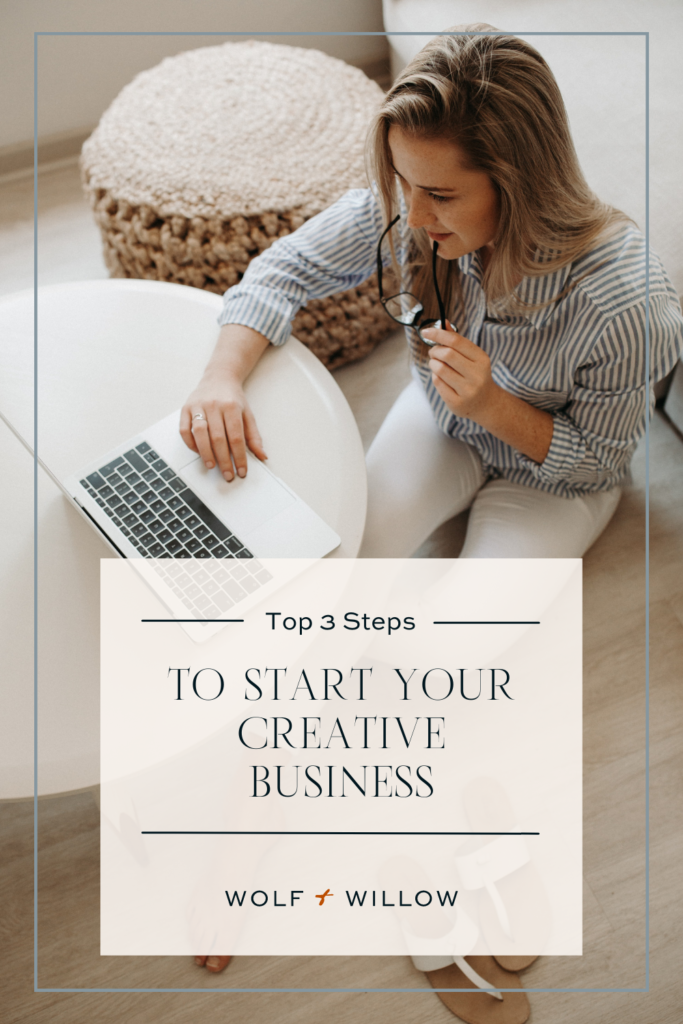Today we’re taking it back… Wayyy back. Back to the beginning (Hilary Duff, anyone?) of starting a creative business. With my 12 years of corporate business experience and over four years of experience building a small business, I want to reflect on my journey to shed some light on what I believe are the top three steps you need to take to start your creative business.
While every person and business is unique, some important foundational steps must be taken early on if you want to build a truly successful business.
I understand as much as anyone how difficult the early stages can be. And I’ve been noticing as I talk to new and aspiring business owners, that they have a lot of the same questions as I did when I began my entrepreneurial journey a few years ago. So I hope that this post clears up some of your questions as well as you start your creative business!
While this is by no means a comprehensive list, I hope that it serves as a first-step roadmap to setting yourself up for success and getting off on the right foot as a new small business owner.

Step 1: Identify your “why”
The first, and arguably most important, step is to identify your “why.” Ask yourself what is the purpose of your starting your creative business?
- Is it the idea of making your own art or the opportunity to create something new and different?
- Is it the chance to work from home, have more control over your schedule
- Or is it simply to make more money?
It doesn’t matter what your “why” is and there’s no right answer. Your “why” is going to be very personal to you, your priorities, and your goals.
No matter what your “why” is, once you understand that thing that motivates you, it’s going to be a lot easier to focus on growing your business because you’ll know why you’re doing all this. Starting (and maintaining) a business is difficult, so when you inevitably run into obstacles, your “why” is going to motivate you to keep going. Plus, it’ll help you craft goals, develop your brand message, and generally influence all other parts of your business. It’s much easier to make decisions about your business when you firmly understand why you want to start a business. It can even help guide you to the type of business you want to start if you were still on the fence or considering your options.
When I first started, I considered many different types of businesses, but landing on web design came from a place of being able to fuse my passion for helping others succeed with my love of creativity.
Pro-tip: If you’re struggling (like so many others!) with the question, “What kind of business should I start?” I highly recommend taking a step back and connecting with why you want to start a business in the first place. My guess is you’ll gain a lot of clarity to help you move forward!
I know creating your “why” can feel like an intimidating task, so here’s a more concrete example to help you out: At Wolf & Willow, we are driven by our passion for helping other small business owners and entrepreneurs succeed by helping them build an authentic and strategic brand and website that helps them grow. By having a solid foundational “why,” we can make goals and decisions for our business from a place of connection and purpose.
Step 2: Identify your “who”
If you’ve been researching how to start a business, you’ve likely heard that you need to “niche” down to be successful. Today’s blog post isn’t going to take an in-depth look into niches specifically, but this concept is better explained and understood if you come at it from a perspective of who you want to serve first.
There are many different ways to “niche down” including:
- Industry
- Type of person
- Service
- Geographical location
…And many more. But at the end of the day, the first question you need to ask yourself is who you want to serve and tie that back to your why.
For me, I wanted to help others succeed by creating beautiful and functional websites. So my niche was narrowed down to web design for small business owners. I was able to take a personal interest and expertise of mine and fuse it with my love of helping others.
This is a concept where a lot of new business owners struggle. One of the best pieces of advice I ever got from a business coach was this: if you’re trying to serve everyone, you’re likely serving no one. By understanding who you want to serve and why you want to serve, you can take the necessary steps to connect with that ideal audience in the most authentic way.
If you’ve been hangin’ around with us long enough you likely know that we here at Wolf & Willow prioritize authentic, genuine human connection. It’s at the root of how we do business.
When you approach your business from a place of purpose and authenticity, your audience will see and connect with that, guaranteed.
Step 3: Identify your MVP (minimum viable product)
Now that you’ve identified who you want to serve and your “why,” the next step is to identify your MVP or your minimum viable product. Before you get too nervous about this technical term, let me break it down. MVP is simply the first version of your business that serves as a proof of concept. It should be something that addresses one specific need or desire of your ideal client.
A big mistake I see a lot of small business owners make is trying to offer too many services or products too soon. Instead, I recommend choosing just one offer to start with and putting all of your efforts into making it the best it can be. To add to that, your number one priority should be creating a product or service with value and a killer customer experience. This is what will set you apart from your competitors and make you known within your industry.
Your MVP should be something tangible and achievable, but it doesn’t have to be too complex or expensive. It’s always better to do one thing really well than to try to do 10 things moderately well.
This also doesn’t mean you can’t make a plan or have some bigger goals. You absolutely should! Having a one, five, or even 10-year plan is essential to understanding where you want to go. Just remember that what your business looks like now shouldn’t look the same as your business five years from now. If it did, there would be no such thing as growth. (And you’d likely overwhelm or burn yourself out in the process.)
One note I have to acknowledge: I understand the fear of not offering various services or products because, at first glance, it can feel like a potential lost opportunity. But trust me — you’ll be far less stressed and more confident in diversifying your offerings later once you’ve established a good process for yourself.
A prime example of this for Wolf & Willow is that we decided not to launch our rebrand with a template shop. This was a tough pill to swallow since I have such a passion for creating templates and how beneficial they can be for especially new business owners with smaller budgets, but the pressure quickly became too much to put my effort into building all of my one-on-one services as well as building quality templates and the customer experiences that went with each one.
After talking it over with my team, we decided to put our full focus on our one-on-one services first, because they all shared a similar client experience and that was very important to me. The experience you have when working with Wolf & Willow should feel like a breath of fresh air — not stressful or confusing. We knew from the beginning we wanted our client experience to be top-notch and we wanted that to be one of the things that set us apart in the industry.
Now we can take pride in knowing that our clients enjoy a seamless, white-glove, and collaborative (and hopefully fun!) process that further fuels their joy in their business and where it’s headed.
There you have it! 3 steps to starting your creative business
I felt like this post was really important because so many of the questions new or aspiring business owners have are somehow connected to these three steps. Steps that are so often overlooked, too! It’s easy to get swept up in other things — what tools you need, a website, CRMs, etc. But this is all putting the cart before the horse and it’s why many times I see aspiring business owners stuck in an endless loop of “getting started.”
If you are one of those people, I encourage you to take a step back and spend some time on these steps to help you get more clarity on the direction you want to go before you get hung up on how to get there.
Still overwhelmed, confused, or have questions? Reach out to me on Instagram! We’re always here to help.
